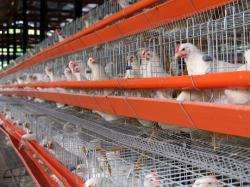USDA Finalizes New Food Safety Measures To Reduce Salmonella And Campylobacter In Poultry
February 4, 2016 | 4 min to read

WASHINGTON — The U.S. Department of Agriculture's (USDA) Food Safety and Inspection Service (FSIS) today announced the finalization of new federal standards to reduce Salmonella and Campylobacter in ground chicken and turkey products, as well as in raw chicken breasts, legs, and wings. Based on scientific risk assessments, FSIS estimates that implementation of these standards will lead to an average of 50,000 prevented illnesses annually.
As part of this move to make chicken and turkey items that Americans frequently purchase safer to eat, FSIS has also updated its microbial testing schedule at poultry facilities and will soon begin posting more information online about individual companies' food safety performance.
"Over the past seven years, USDA has put in place tighter and more strategic food safety measures than ever before for meat and poultry products. We have made strides in modernizing every aspect of food safety inspection, from company record keeping, to labeling requirements, to the way we perform testing in our labs," said Agriculture Secretary Tom Vilsack. "These new standards, in combination with greater transparency about poultry companies' food safety performance and better testing procedures, will help prevent tens of thousands of foodborne illnesses every year, reaching our Healthy People 2020 goals."
FSIS uses pathogen reduction performance standards to assess the food safety performance of establishments that prepare meat and poultry products. By making the standards for ground poultry tougher to meet, ground poultry products nationwide will have less contamination and therefore result in fewer foodborne illnesses. FSIS implemented performance standards for whole chickens in 1996 but has since learned that Salmonella levels increase as chicken is further processed into parts. Poultry parts like breasts, wings and others represent 80 percent of the chicken available for Americans to purchase. By creating a standard for chicken parts, and by performing regulatory testing at a point closer to the final product, FSIS can greatly reduce consumer exposure to Salmonella and Campylobacter.
"This approach to poultry inspection is based on science, supported by strong data, and will truly improve public health," said USDA Deputy Under Secretary for Food Safety Al Almanza. "The new performance standards will complement the many other proactive, prevention-based food policies that we've put in place in recent years to make America's supply of meat and poultry safer to eat."
For chicken parts, ground chicken, and ground turkey, FSIS is finalizing a pathogen reduction performance standard designed to achieve at least a 30 percent reduction in illnesses from Salmonella. For chicken parts and ground chicken, FSIS is finalizing a pathogen reduction performance standard designed to achieve at least a 32 percent reduction in illnesses from Campylobacter. Because FSIS has found the prevalence for Campylobacter in ground turkey to be already low, the reduction for this product is estimated to be 19 percent.
After these standards were proposed in early 2015, FSIS began to use routine sampling throughout the year rather than infrequent sampling on consecutive days to assess whether establishments' processes are effectively addressing Salmonella and Campylobacter. Once establishments have completed a full set of testing under the new standards, the agency will also begin posting online which facilities pass, meet or fail the new standards.
An estimated 1.2 million foodborne illnesses are thought to be caused every year by Salmonella, with approximately one-third or 360,000 of those illnesses attributed to FSIS-regulated products. In 2013, the agency released a Salmonella Action Plan, which created a blueprint for the agency to address this pathogen of significant public health concern. Today's announcement fulfills the major steps that FSIS had outlined in its plan.
Over the past six years, USDA has collaborated extensively with other federal partners to safeguard America's food supply, prevent foodborne illnesses and improve consumers' knowledge about the food they eat. USDA's FSIS is working to strengthen federal food safety efforts and develop strategies that emphasize a three-dimensional approach to prevent foodborne illness: prioritizing prevention; strengthening surveillance and enforcement; and improving response and recovery.
Some of the other steps taken to improve the safety of meat and poultry include adopting a zero-tolerance policy for raw beef products containing six additional strains of shiga-toxin producing E. coli; ensuring that beef products that have been mechanically tenderized are labeled as such and include validated cooking instructions; implementing a new "test and hold" policy in 2012, which significantly reduces consumer exposure to unsafe meat products; and working closely with FDA and CDC to collectively form the Interagency Food Safety Analytics Collaboration (IFSAC), which focuses on projects related to foodborne illness source attribution and will try to improve the classification of foods implicated in foodborne disease outbreaks.
Consumers with food safety questions can "Ask Karen," the FSIS virtual representative available 24 hours a day at AskKaren.gov or via smartphone at m.askkaren.gov.The toll-free USDA Meat and Poultry Hotline 1-888-MPHotline (1-888-674-6854) is available in English and Spanish and can be reached from l0 a.m. to 4 p.m. (Eastern Time) Monday through Friday. Recorded food safety messages are available 24 hours a day. The online Electronic Consumer Complaint Monitoring System can also be accessed 24 hours a day at: www.fsis.usda.gov/reportproblem.
Source: USDA
